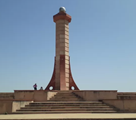Mangarh Hillock: Adivasis’ Jallianwala
The National Monument Authority recently submitted a report to the Union Ministry of Culture to declare Mangarh Hillock a ‘Monument of National Importance’.

- The hillock, situated at the Gujarat-Rajasthan border, is a site of a tribal uprising where a massacre of over 1500 Bhil tribal freedom fighters took place in 1913.
- The place is also known as the Adivasi Jallianwala.
| About Bhil Reformer Govind Guru & the Background for the Massacre - Govind Guru, born to a Vanzara family near Dungarpur in Rajasthan in 1874, started working with the Bhil community during the great famine of 1899-1900 and saw their oppression at the hands of the princely states.
- The community was always in debt that lingered for generations and thus Bhils worked as bonded labourers at farms. Govind Guru saw the social setup and liquor as the primary causes of woes and decided to fight the malaise.
- The guru's disciples followed strict rules including abstinence from liquor and meat, the adoption of hygienic practices, and the rejection of bonded labour work and witch-doctors. These reforms did not go down well with many princely states as revenues from liquor shops went down and labour became scarce. The struggle between the states and Bhils had started.
- States started harassing Govind Guru's followers. That brought together a massive congregation at Mangarh hills in November 1913 in support of the demand for a separate state for Bhils. He was the pivotal force in uniting Bhils to demand a separate entity in the British period. The movement led to the infamous Mangarh massacre on November 17, 1913 when British forces opened fire on tribals gathered at the site killing over 1,500.
- He started Bhagat Sampradaya (sect) in 1908 to socially and morally uplift the Bhil community. He founded "Samp Sabha" and spread public awareness against evils and orthodox traditions of tribal society.
|





